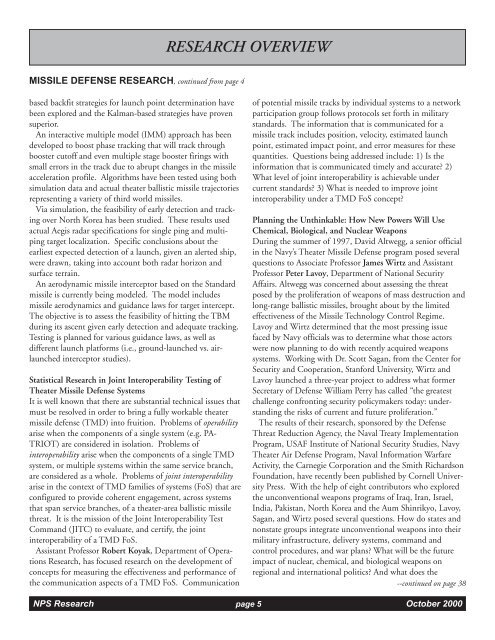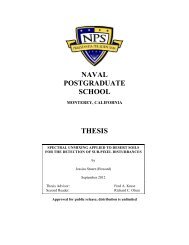October 2000 Newsletter - Naval Postgraduate School
October 2000 Newsletter - Naval Postgraduate School
October 2000 Newsletter - Naval Postgraduate School
Create successful ePaper yourself
Turn your PDF publications into a flip-book with our unique Google optimized e-Paper software.
MISSILE DEFENSE RESEARCH, continued from page 4<br />
based backfit strategies for launch point determination have<br />
been explored and the Kalman-based strategies have proven<br />
superior.<br />
An interactive multiple model (IMM) approach has been<br />
developed to boost phase tracking that will track through<br />
booster cutoff and even multiple stage booster firings with<br />
small errors in the track due to abrupt changes in the missile<br />
acceleration profile. Algorithms have been tested using both<br />
simulation data and actual theater ballistic missile trajectories<br />
representing a variety of third world missiles.<br />
Via simulation, the feasibility of early detection and tracking<br />
over North Korea has been studied. These results used<br />
actual Aegis radar specifications for single ping and multiping<br />
target localization. Specific conclusions about the<br />
earliest expected detection of a launch, given an alerted ship,<br />
were drawn, taking into account both radar horizon and<br />
surface terrain.<br />
An aerodynamic missile interceptor based on the Standard<br />
missile is currently being modeled. The model includes<br />
missile aerodynamics and guidance laws for target intercept.<br />
The objective is to assess the feasibility of hitting the TBM<br />
during its ascent given early detection and adequate tracking.<br />
Testing is planned for various guidance laws, as well as<br />
different launch platforms (i.e., ground-launched vs. airlaunched<br />
interceptor studies).<br />
Statistical Research in Joint Interoperability Testing of<br />
Theater Missile Defense Systems<br />
It is well known that there are substantial technical issues that<br />
must be resolved in order to bring a fully workable theater<br />
missile defense (TMD) into fruition. Problems of operability<br />
arise when the components of a single system (e.g. PA-<br />
TRIOT) are considered in isolation. Problems of<br />
interoperability arise when the components of a single TMD<br />
system, or multiple systems within the same service branch,<br />
are considered as a whole. Problems of joint interoperability<br />
arise in the context of TMD families of systems (FoS) that are<br />
configured to provide coherent engagement, across systems<br />
that span service branches, of a theater-area ballistic missile<br />
threat. It is the mission of the Joint Interoperability Test<br />
Command (JITC) to evaluate, and certify, the joint<br />
interoperability of a TMD FoS.<br />
Assistant Professor Robert Koyak, Department of Operations<br />
Research, has focused research on the development of<br />
concepts for measuring the effectiveness and performance of<br />
the communication aspects of a TMD FoS. Communication<br />
RESEARCH OVERVIEW<br />
of potential missile tracks by individual systems to a network<br />
participation group follows protocols set forth in military<br />
standards. The information that is communicated for a<br />
missile track includes position, velocity, estimated launch<br />
point, estimated impact point, and error measures for these<br />
quantities. Questions being addressed include: 1) Is the<br />
information that is communicated timely and accurate? 2)<br />
What level of joint interoperability is achievable under<br />
current standards? 3) What is needed to improve joint<br />
interoperability under a TMD FoS concept?<br />
Planning the Unthinkable: How New Powers Will Use<br />
Chemical, Biological, and Nuclear Weapons<br />
During the summer of 1997, David Altwegg, a senior official<br />
in the Navy’s Theater Missile Defense program posed several<br />
questions to Associate Professor James Wirtz and Assistant<br />
Professor Peter Lavoy, Department of National Security<br />
Affairs. Altwegg was concerned about assessing the threat<br />
posed by the proliferation of weapons of mass destruction and<br />
long-range ballistic missiles, brought about by the limited<br />
effectiveness of the Missile Technology Control Regime.<br />
Lavoy and Wirtz determined that the most pressing issue<br />
faced by Navy officials was to determine what those actors<br />
were now planning to do with recently acquired weapons<br />
systems. Working with Dr. Scott Sagan, from the Center for<br />
Security and Cooperation, Stanford University, Wirtz and<br />
Lavoy launched a three-year project to address what former<br />
Secretary of Defense William Perry has called “the greatest<br />
challenge confronting security policymakers today: understanding<br />
the risks of current and future proliferation.”<br />
The results of their research, sponsored by the Defense<br />
Threat Reduction Agency, the <strong>Naval</strong> Treaty Implementation<br />
Program, USAF Institute of National Security Studies, Navy<br />
Theater Air Defense Program, <strong>Naval</strong> Information Warfare<br />
Activity, the Carnegie Corporation and the Smith Richardson<br />
Foundation, have recently been published by Cornell University<br />
Press. With the help of eight contributors who explored<br />
the unconventional weapons programs of Iraq, Iran, Israel,<br />
India, Pakistan, North Korea and the Aum Shinrikyo, Lavoy,<br />
Sagan, and Wirtz posed several questions. How do states and<br />
nonstate groups integrate unconventional weapons into their<br />
military infrastructure, delivery systems, command and<br />
control procedures, and war plans? What will be the future<br />
impact of nuclear, chemical, and biological weapons on<br />
regional and international politics? And what does the<br />
--continued on page 38<br />
NPS Research page 5<br />
<strong>October</strong> <strong>2000</strong>
















